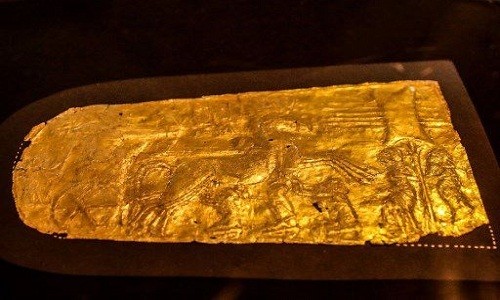Spectacular gold artifacts found in the tomb of Pharaoh Tutankhamun have been revealed for the first time in nearly a century.
 |
| A gold artifact from the tomb of Pharaoh Tutankhamen. Photo: AFP |
According to the International Business Times, Egyptian pharaoh Tutankhamun’s golden treasure has been on public display for the first time after 95 years of discovering the king’s tomb. The artifacts have been stored in the Egyptian Museum in Cairo for a century without being analyzed or restored.
The exhibit, which opened on November 15, will feature gold jewelry, with figurines from eastern Mesopotamia dating back to BC. “The objects associated with the pharaoh Tutankhamen’s chariot are in very poor condition,” said Christian Ekmann, a German conservationist.
The tomb of the 19-year-old pharaoh was first discovered in 1922 by British archaeologist Howard Carter. Despite extensive looting and natural destruction, there are still more than 5,300 objects in the tomb, including solid gold arks, gold masks, thrones, bows and arrows, trumpets, lotus-shaped cups, food, wine, shoes and linen underwear.

The treasure included 100 ornate gold plates used for bows and quills, balls and bridles, all of which had been transported hundreds of kilometers to the pharaoh’s final resting place. On the faces of some of the artifacts are images of animals and goats fighting against trees, images that are foreign to Egyptian culture and images that are believed to come from the Levant or present-day Syria.
“We assume that these highly developed decorative styles in Mesopotamia were transferred through Syria to the Mediterranean Sea and Egypt. This again shows the great role of ancient Syria in the diffusion of culture during the Bronze Age,” said Professor Peter Falzner at the University. Tübingen, Germany.
In 1922, sealed gold artifacts were found in a chest. Archaeologists successfully recovered the artifacts after spending several hours in the guard room at the Egyptian Museum. They also made pictures of the resources to conduct a comprehensive survey.
Professor Pfalzner and his colleagues determined that the artifacts were transported 650 kilometers across desert and waterways to present-day Cairo. The ancient Egyptians did not build roads to travel across their territory, but mainly used waterways because most of the major cities were located along the banks of the Nile River.





